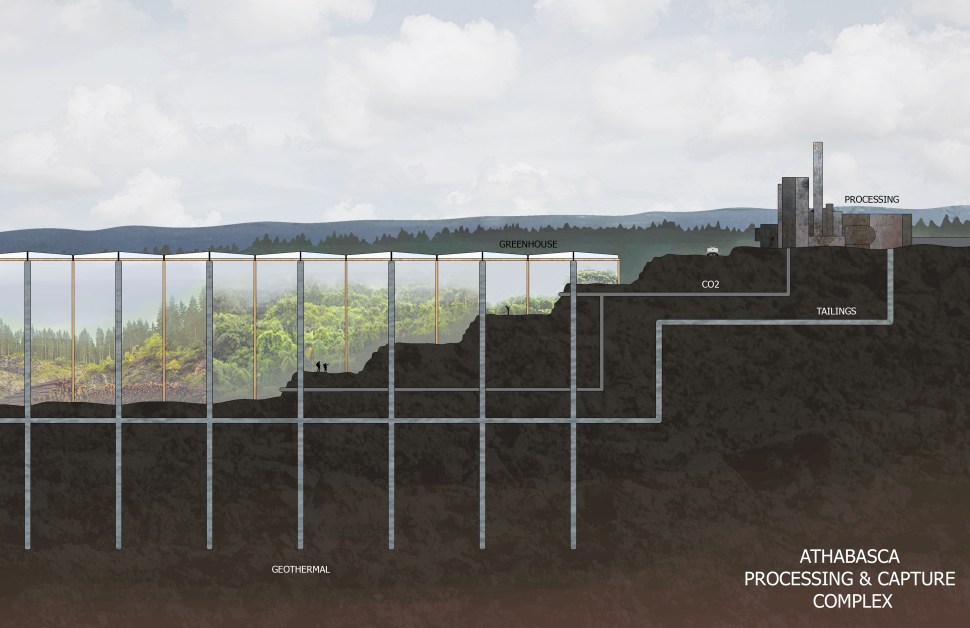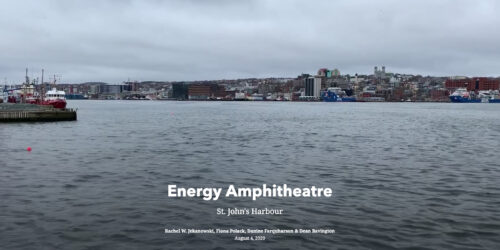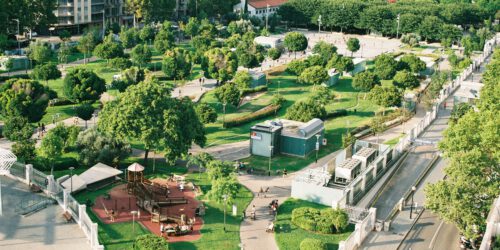Designing Canadian Energy Futures

This post by W. Douglas Robb originally appeared as part of a series on Environmental Histories of the Future on NiCHE, the Network in Canadian History & Environment.
The economist Harold Innis once claimed that Canadians were mere “hewers of wood and drawers of water”; in other words, that Canada was a nation of abundant natural resources ripe for the taking.[1] We now recognize how Innis’ simplistic remark obscures important debates about the role of energy resources in Canada. Contemporary discourses of decarbonization, climate justice, and Indigenous sovereignty (among many others) reveal the complex and contradictory perspectives that characterize the design and construction of Canada’s energy landscapes. While some argue for the continued extraction of hydrocarbons as a pragmatic bridge to a low-carbon future, others advocate for a more rapid—and radical—socio-technical transition. Many pathways exist in between, all of which present unique risks and opportunities.
How can these debates inform the construction of Canada’s energy system? More specifically, how can attention to the environmental histories of contemporary energy projects influence the design of our future energy landscapes? Design plays a central role in production of infrastructures that link people to landscapes of energy extraction, generation, and transmission across Canada and throughout the global energy system. Architects and landscape architects increasingly find themselves at the centre of these complex debates. During the COVID-19 pandemic, designers have been repeatedly told that our current historical moment offers an unprecedented opportunity to “build back better”;[2] and to envision a more just and sustainable society centred on the decarbonization of the economy guided by a program of social and environmental justice.[3] These goals are important, urgent, and necessary; nowhere can we observe their convergence more vividly than in debates surrounding the future of energy landscapes in Canada.
But before architects and landscape architects, like myself, can begin to design Canada’s future energy landscapes and built environments, we need to first understand how we arrived at our present system. Landscapes of energy and electricity are characterized by complex relationships that traverse multiple disciplinary boundaries. Therefore, designers must familiarize themselves with the various conversations and debates within energy discourse, ranging from the technical jargon of petrochemical geoengineering to discourses of community opposition to the siting of a renewable energy infrastructures—as well as countless other social, cultural, and political considerations that influence the design process. These debates intersect in particular places in highly specific ways. It’s the designer’s job to make sense of them all and to design an appropriate and acceptable proposal.
In the Spring of 2021, I set out to explore these debates through a seminar I taught at the Daniels Faculty of Architecture, Landscape, and Design at the University of Toronto. This course, called Designing Canadian Energy Futures, convened an interdisciplinary conversation with artists, activists, government officials, industry representatives, and Indigenous leaders who represent diverse—and often oppositional—perspectives regarding the design of Canada’s future energy system.
The seminar was structured in two parts. In Part 1, students were assigned to groups to explore five key fuel sources that make up Canada’s energy system: oil, natural gas, hydropower, nuclear energy, and renewables. Each week, expert guest speakers provided a detailed overview of each fuel’s particular geographies, politics, and materialities. While this approach was invaluable to build students’ technical literacy of their assigned fuel source, the structure of a week-by-week analysis produced a false impression that Canada’s energy resources existed in isolation from one another. To remedy this misunderstanding, Part 2 re-evaluated each fuel source through a series of cross-cutting debates pertaining to topics such as the grid, land, water, air, and people. These thematic lectures sought to problematize each fuel source and to reveal the spatial, temporal, and relational dynamics that characterize Canada’s energy system.
In keeping with the theme of a formal debate, students were asked to select an existing energy project that corresponded with their chosen fuel source and to examine it from opposing “affirmative” and “negative” positions. In the “negative” assignment, students were tasked with visualizing a failed version of their project as it might exist in the future based on current risks and vulnerabilities, such as climate change or social resistance. This speculative design exercise—known as a premortem[4]—required students to analyze the environmental histories of previous energy projects alongside projected economic and climate conditions in order to imagine potential energy futures through their chosen site.

(image courtesy of Alice Dong).
This approach yielded a number of insightful visualizations, and forced students to confront the divergent risks and opportunities inherent within each of their energy projects. For example, Alice Dong grappled with the benefits of emissions-free electricity from the Muskrat Falls Dam (currently under construction on the Churchill River in Labrador) alongside environmental histories of spatial injustice associated with methylmercury bioaccumulation in hydroelectric reservoirs (Figure 1).[5] Other projects were more speculative, almost verging on creative non-fiction. For instance, Vail Zerr analyzed the risks of intensive logging, climate change, and increased wildfires surrounding the Fort St. James bioenergy plant in British Columbia from the perspective of a future environmental assessment officer (Figure 2). Both projects successfully demonstrate how inventive—yet unnervingly plausible—future energy scenarios could be borne out of careful attention to past and present environmental conditions.

In Part 2 of the seminar, students were asked to the consider the various debates and perspectives discussed in class, and to produce a design for a speculative energy project. This was not an easy task, as it required students to balance the needs and values of multiple actors (both human and nonhuman) implicated within the expanded field of their proposed project. As each guest speaker made abundantly clear, all Canadian energy landscapes are intrinsically plural: they all contain multiple meanings, values, and promises for the future articulated through the design of landscapes and infrastructures in the present.[6] The design of an energy project is therefore a deeply political act, and the ideological differences that characterize Canada’s energy system can appear (and often are) fundamentally irreconcilable. This complex terrain set the stage for the final assignment, and stimulated students to produce innovative research agendas and inventive design proposals.
The students’ final projects can be generally organized into two broad categories, which I term as “practical solutions” and “innovative alternatives”. In many ways, these categories reflect the familiar normative tensions found in contemporary energy debates between so-called pragmatists and radicals. The pragmatic position seeks to move towards decarbonization in a measured, incremental way so as to not destabilize the economies and social structures that depend on Canada’s extraction-based economy (specifically, oil and natural gas). Conversely, the more radical position calls for a rapid and wholesale reconfiguration of Canada’s energy system away from fossil fuels and towards a decentralized grid powered by renewables, hydro, and, in some instances, small modular nuclear reactors (SMRs). Both camps mobilize rhetorical arguments grounded in discourses of social justice and economic benefits, but in very different ways as evidenced by the students’ final projects.

Clayton Zdan’s proposed energy landscape can be interpreted as a practical response to Canada’s current energy system. His project acknowledges the economic and social importance of oil in western Canada, and seeks to capitalize on the industrial by-products of steam-assisted gravity drainage (SAGD) in order to catalyze opportunities for carbon capture and sequestration (Figure 3). His sectional visualization of a proposed carbon capture complex merges the spatial and topographic logics of oil extraction with the familiar architectural typology of the greenhouse—albeit a greenhouse warmed by the excess heat generated by the liquefaction of bituminous oil sands deep underground.

Diana Koulouthros’ project similarly seeks to reconcile the environmental harms associated with Canada’s oil and gas sector by redesigning a portion of the Co-Op Refinery Complex located northeast of Regina. The process of refining oil consumes tremendous volumes of water, which the Co-Op Complex currently draws from underground aquifers as well as the City of Regina’s municipal supply. Diana’s proposal utilizes heat and electricity from the Refinery to power an integrated bioreactor and water filtration plant in order to encourage effective wastewater recycling and to mitigate future issues of water scarcity (Figure 4).
Much like Clayton’s greenhouse, Diana’s water treatment plant represents an incremental, yet plausible step towards decarbonization by hacking the physical infrastructures of our current energy system. A similar approach can be seen in Blair Kern’s proposal for a distributed, small-scale hydroelectric network within Metro Vancouver’s stormwater system (Figure 5). Blair’s project is unique, however, because it seeks to transpose faraway landscapes of hydropower generation—typically associated with extensive flooding and environmental degradation—onto one of Canada’s most densely populated urban centres. While the technical practicality of coupling stormwater infrastructure with electricity generation is unclear, the project succeeds in demonstrating how a designed landscape can connect people to the source of their electricity in order to reveal sociotechnical relationships that are otherwise rendered invisible by the infrastructure of the grid.

As my students and I discovered over the course the seminar, all energy landscapes are characterized by simultaneous and contradictory ways that we ascribe value to a particular place; whether as a lucrative site of resource extraction, a scenic cultural landscape, or a homeland inhabited since time immemorial. All too often, these meanings and values are elided in the technical jargon of decarbonization, which often fails to articulate energy as a socially- and culturally-embedded concept. The projects envisioned by the students in Designing Canadian Energy Futuresoffer design responses to some of the most challenging and complex debates in Canada’s social and political discourse. They also offer a powerful reminder that we must learn from the mistakes of past energy projects to ensure that the failures and constitutive injustices of our current energy system are not replicated in our designs for the future.
[1] Harold A. Innis, The Fur Trade in Canada: An Introduction to Canadian Economic History (Toronto: University of Toronto Press, 1927).
[2] Governor General of Canada, “A Stronger and More Resilient Canada: Speech from the Throne to Open the Second Session of the Forty-Third Parliament of Canada” (September 23, 2020).
[3] Billy Fleming, “Design and the Green New Deal,” Places Journal (April 2019).
[4] Marcella Eaton, “Pre-Mortem: A Landscape Approach to Northern Manitoba,” in Fresh water: Design Research for Inland Water Territories, ed. Mary Pat McGuire and Jessica M. Henson (San Francisco: ORO Editions, 2019), 57-70.
[5] Ryan S.D. Calder et al., “Future Impacts of Hydroelectric Power Development on Methylmercury Exposures of Canadian Indigenous Communities,” Environmental Science & Technology 50, no. 23 (2019): 13115-13122.
[6] Jane Wolff, “Portfolio: Sites, Stories, Representations, Citizens,” in Site Matters, ed. Carol J. Burns and Andrea Kahn (London: Routledge, 2021), 204-214; Nikhil Anand, Akhil Gupta, and Hannah Appel (eds.), The Promise of Infrastructure (Durham, NC: Duke University Press, 2018).






1 Response